Descripción
Classic Editor es un plugin oficial mantenido por el equipo de WordPress que restaura el anterior editor (“clásico”) de WordPress, y la pantalla de “Editar entrada”. Permite usar plugins que usen esa pantalla, añadan cajas meta al viejo estilo, o dependan de algún modo del editor anterior.
Editor clásico es un plugin oficial de WordPress, y será totalmente compatible y mantenido hasta por lo menos 2024, o el tiempo que sea necesario.
En resumen, este plugin agrega lo siguiente:
- Los administradores puede elegir el editor por defecto para todos los usuarios.
- Los administradores pueden permitir a los usuarios cambiar su editor predeterminado.
- Cuando se permite, los usuarios puede elegir qué editor usar para cada entrada.
- Cada entrada se abre en el último editor independientemente de quién la editó por última vez. Esto es importante para mantener una experiencia consistente al editar contenido.
Además, el plugin Classic Editor incluye varios filtros que permiten que otros plugins controlen los ajustes y la elección de editor por publicación y por tipo de contenido.
Por defecto, este plugin oculta todas las funcionalidades disponibles en el nuevo editor de bloques (“Gutenberg”).
Capturas
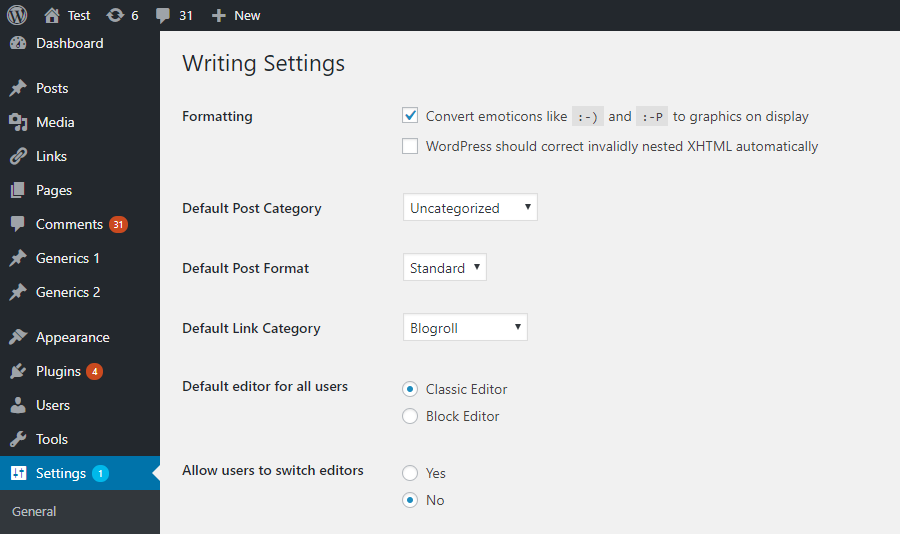
Ajustes del administrador en la pantalla Ajustes -> Escritura. 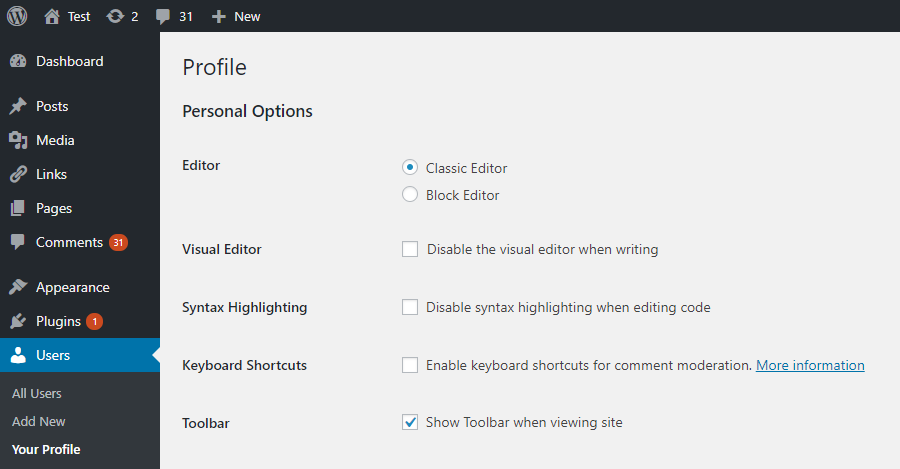
Ajustes de usuario en la pantalla Perfil. Visible cuando los usuarios tienen permitido cambiar de editor. 
"Enlaces de acción" para elegir editor alternativo. Visible cuando los usuarios tienen permitido cambiar de editor. 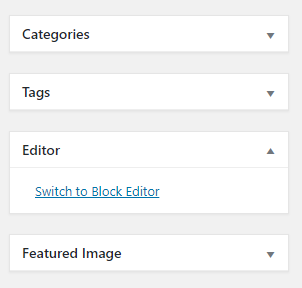
Enlace para cambiar al Editor de bloques cuando estás editando una entrada en el editor de clásico. Visible cuando los usuarios tienen permitido cambiar de editor. 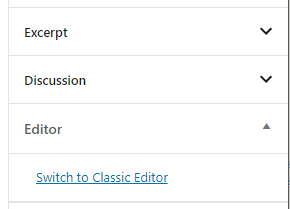
Enlace para cambiar al editor clásico cuando estás editando una entrada en el editor de bloques. Visible cuando los usuarios tienen permitido cambiar de editor. 
Ajustes de red para seleccionar el editor predeterminado para la red y permitir que los administradores del sitio lo cambien. 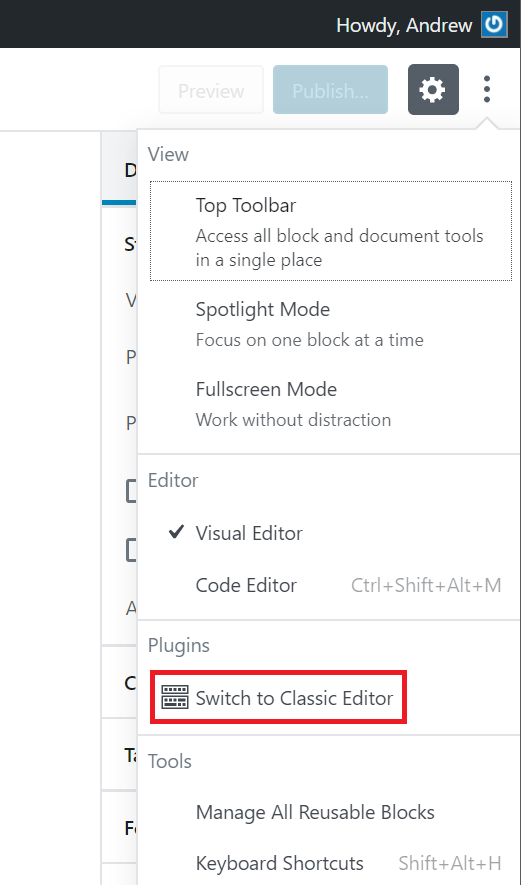
El enlace para "Cambiar al editor clásico".
Preguntas frecuentes
-
Ajustes predeterminados
-
When activated and when using a classic (non-block) theme, this plugin will restore the previous (“classic”) WordPress editor and hide the new block editor (“Gutenberg”).
These settings can be changed at the Settings => Writing screen. -
Ajustes predeterminados para la instalación en red
-
Hay dos opciones:
- Cuando se activa el plugin para la red, y cuando se usa un tema clásico (no de bloques) este plugin establecerá el editor clásico como por defecto e impedirá que los administradores y usuarios del sitio cambien de editor.
Los ajustes se pueden cambiar y el editor predeterminado de toda la red se puede seleccionar en la pantalla de los ajustes de red. - Cuando no está activado por la red, cada administrador del sitio podrá activar el plugin y elegir las opciones para sus usuarios.
- Cuando se activa el plugin para la red, y cuando se usa un tema clásico (no de bloques) este plugin establecerá el editor clásico como por defecto e impedirá que los administradores y usuarios del sitio cambien de editor.
-
No está el enlace para “Cambiar al editor clásico”
-
Está en el menú principal del editor de bloques, dale un vistazo a esta captura de pantalla.
-
Does this work with full site editing and block themes?
-
No, as block themes rely on blocks. See Block themes article for more information.
Reseñas
Colaboradores y desarrolladores
“Classic Editor” es un software de código abierto. Las siguientes personas han colaborado con este plugin.
Colaboradores“Classic Editor” ha sido traducido a 72 idiomas. Gracias a los traductores por sus contribuciones.
Traduce “Classic Editor” a tu idioma.
¿Interesado en el desarrollo?
Revisa el código , echa un vistazo al repositorio SVN , o suscríbete al log de desarrollo por RSS .
Registro de cambios
1.6.3
- Added some WPCS fixes, props NicktheGeek on GitHub.
- Updated “Tested up to” in the readme and removed it from classic-editor.php. This should fix false positive errors in security plugins in the future.
1.6.2
- Se corrigió un error que impedía guardar el último editor utilizado.
1.6.1
- Fixed a warning on the block editor based widgets screen.
- Se corrigió el uso de un filtro obsoleto.
1.6
- Actualizado para WordPress 5.5.
- Corregidos problemas menores con llamadas a funciones obsoletas, un innecesario registro de hook de desinstalación y capitalización de algunas cadenas.
1.5
- Actualizado para WordPress 5.2 y Gutenberg 5.3.
- Se mejoró y corrigió la lógica de “abrir las entradas con el último editor que se usó para editarlas”.
- Corregido el estado de agregar entrada para que puedan acceder otros plugins.
1.4
- En las instalaciones de red se sacó la restricción de activar solo para la red.
- Se agregó compatibilidad para que los administradores de la red puedan elegir el editor predeterminado para toda la red.
- Corregido el enlace a los ajustes en la advertencia de la pantalla de “Acerca de”, de la red.
- Se agregó correctamente el elemento de menú “Cambiar al editor clásico”, en el menú del editor de bloques.
1.3
- Se solucionó la eliminación del widget de escritorio “Prueba Gutenberg”.
- Condición fija para visualizar el aviso de actualización en la pantalla “Novedades”. Se muestra cuando se selecciona el editor clásico y los usuarios no pueden cambiar de editor.
1.2
- Fixed switching editors from the Add New (post) screen before a draft post is saved.
- Fixed typo that was appending the edit URL to the
classic-editorquery var. - Changed detecting of WordPress 5.0 to not use version check. Fixes a bug when testing 5.1-alpha.
- Changed the default value of the option to allow users to switch editors to false.
- Added disabling of the Gutenberg plugin and lowered the required WordPress version to 4.9.
- Added
classic_editor_network_default_settingsfilter.
1.1
Se solucionó un fallo por el que podría intentar cargar el editor de bloques para tipos de contenido no compatibles con el editor, cuando a los usuarios se les permite cambiar de editor.
1.0
- Updated for WordPress 5.0.
- Changed all “Gutenberg” names/references to “block editor”.
- Refreshed the settings UI.
- Removed disabling of the Gutenberg plugin. This was added for testing in WordPress 4.9. Users who want to continue following the development of Gutenberg in WordPress 5.0 and beyond will not need another plugin to disable it.
- Added support for per-user settings of default editor.
- Added support for admins to set the default editor for the site.
- Added support for admins to allow users to change their default editor.
- Added support for network admins to prevent site admins from changing the default settings.
- Added support to store the last editor used for each post and open it next time. Enabled when users can choose default editor.
- Added “post editor state” in the listing of posts on the Posts screen. Shows the editor that will be opened for the post. Enabled when users can choose default editor.
- Added
classic_editor_enabled_editors_for_postandclassic_editor_enabled_editors_for_post_typefilters. Can be used by other plugins to control or override the editor used for a particular post of post type. - Added
classic_editor_plugin_settingsfilter. Can be used by other plugins to override the settings and disable the settings UI.
0.5
- Updated for Gutenberg 4.1 and WordPress 5.0-beta1.
- Removed some functionality that now exists in Gutenberg.
- Fixed redirecting back to the classic editor after looking at post revisions.
0.4
- Fixed removing of the “Try Gutenberg” call-out when the Gutenberg plugin is not activated.
- Fixed to always show the settings and the settings link in the plugins list table.
- Updated the readme text.
0.3
- Updated the option from a checkbox to couple of radio buttons, seems clearer. Thanks to @designsimply for the label text suggestions.
- Some general updates and cleanup.
0.2
- Update for Gutenberg 1.9.
- Remove warning and automatic deactivation when Gutenberg is not active.
0.1
Versión inicial.